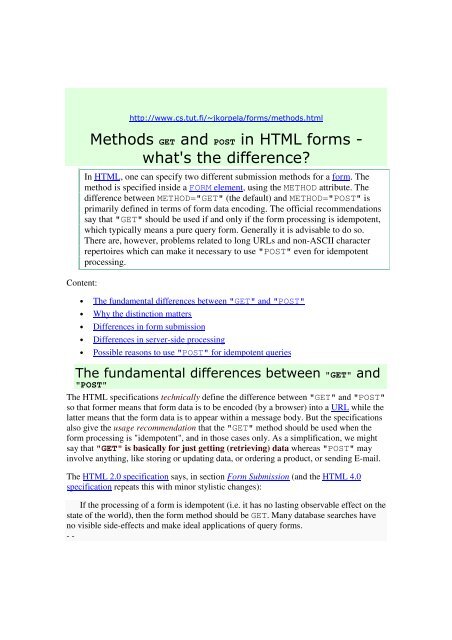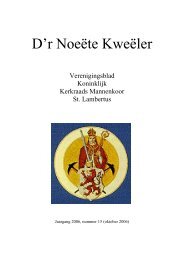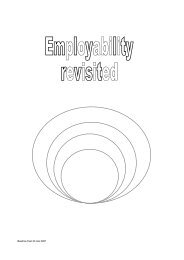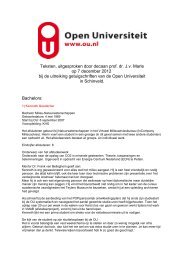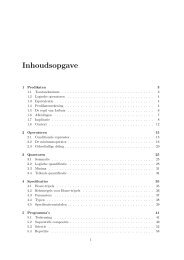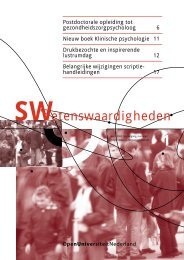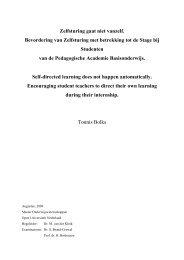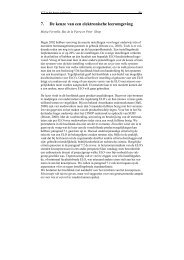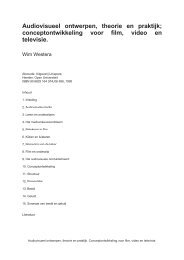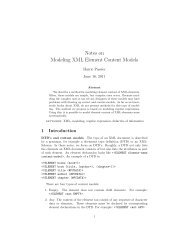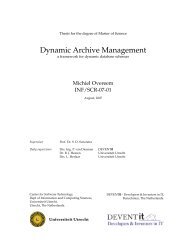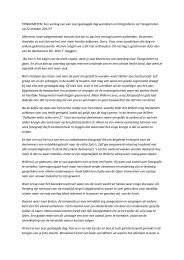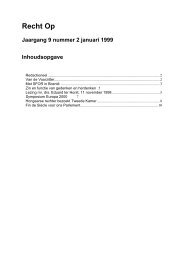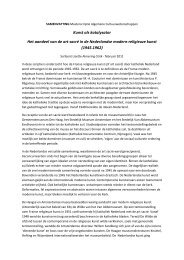Methods GET and POST in HTML forms - what's the difference?
Methods GET and POST in HTML forms - what's the difference?
Methods GET and POST in HTML forms - what's the difference?
You also want an ePaper? Increase the reach of your titles
YUMPU automatically turns print PDFs into web optimized ePapers that Google loves.
Content:<br />
http://www.cs.tut.fi/~jkorpela/<strong>forms</strong>/methods.html<br />
<strong>Methods</strong> <strong>GET</strong> <strong>and</strong> <strong>POST</strong> <strong>in</strong> <strong>HTML</strong> <strong>forms</strong> -<br />
<strong>what's</strong> <strong>the</strong> <strong>difference</strong><br />
In <strong>HTML</strong>, one can specify two different submission methods for a form. The<br />
method is specified <strong>in</strong>side a FORM element, us<strong>in</strong>g <strong>the</strong> METHOD attribute. The<br />
<strong>difference</strong> between METHOD="<strong>GET</strong>" (<strong>the</strong> default) <strong>and</strong> METHOD="<strong>POST</strong>" is<br />
primarily def<strong>in</strong>ed <strong>in</strong> terms of form data encod<strong>in</strong>g. The official recommendations<br />
say that "<strong>GET</strong>" should be used if <strong>and</strong> only if <strong>the</strong> form process<strong>in</strong>g is idempotent,<br />
which typically means a pure query form. Generally it is advisable to do so.<br />
There are, however, problems related to long URLs <strong>and</strong> non-ASCII character<br />
repertoires which can make it necessary to use "<strong>POST</strong>" even for idempotent<br />
process<strong>in</strong>g.<br />
• The fundamental <strong>difference</strong>s between "<strong>GET</strong>" <strong>and</strong> "<strong>POST</strong>"<br />
• Why <strong>the</strong> dist<strong>in</strong>ction matters<br />
• Differences <strong>in</strong> form submission<br />
• Differences <strong>in</strong> server-side process<strong>in</strong>g<br />
• Possible reasons to use "<strong>POST</strong>" for idempotent queries<br />
The fundamental <strong>difference</strong>s between "<strong>GET</strong>" <strong>and</strong><br />
"<strong>POST</strong>"<br />
The <strong>HTML</strong> specifications technically def<strong>in</strong>e <strong>the</strong> <strong>difference</strong> between "<strong>GET</strong>" <strong>and</strong> "<strong>POST</strong>"<br />
so that former means that form data is to be encoded (by a browser) <strong>in</strong>to a URL while <strong>the</strong><br />
latter means that <strong>the</strong> form data is to appear with<strong>in</strong> a message body. But <strong>the</strong> specifications<br />
also give <strong>the</strong> usage recommendation that <strong>the</strong> "<strong>GET</strong>" method should be used when <strong>the</strong><br />
form process<strong>in</strong>g is "idempotent", <strong>and</strong> <strong>in</strong> those cases only. As a simplification, we might<br />
say that "<strong>GET</strong>" is basically for just gett<strong>in</strong>g (retriev<strong>in</strong>g) data whereas "<strong>POST</strong>" may<br />
<strong>in</strong>volve anyth<strong>in</strong>g, like stor<strong>in</strong>g or updat<strong>in</strong>g data, or order<strong>in</strong>g a product, or send<strong>in</strong>g E-mail.<br />
The <strong>HTML</strong> 2.0 specification says, <strong>in</strong> section Form Submission (<strong>and</strong> <strong>the</strong> <strong>HTML</strong> 4.0<br />
specification repeats this with m<strong>in</strong>or stylistic changes):<br />
If <strong>the</strong> process<strong>in</strong>g of a form is idempotent (i.e. it has no last<strong>in</strong>g observable effect on <strong>the</strong><br />
state of <strong>the</strong> world), <strong>the</strong>n <strong>the</strong> form method should be <strong>GET</strong>. Many database searches have<br />
no visible side-effects <strong>and</strong> make ideal applications of query <strong>forms</strong>.<br />
- -
If <strong>the</strong> service associated with <strong>the</strong> process<strong>in</strong>g of a form has side effects (for example,<br />
modification of a database or subscription to a service), <strong>the</strong> method should be <strong>POST</strong>.<br />
In <strong>the</strong> HTTP specifications (specifically RFC 2616) <strong>the</strong> word idempotent is def<strong>in</strong>ed as<br />
follows:<br />
<strong>Methods</strong> can also have <strong>the</strong> property of "idempotence" <strong>in</strong> that (aside from error or<br />
expiration issues) <strong>the</strong> side-effects of N > 0 identical requests is <strong>the</strong> same as for a s<strong>in</strong>gle<br />
request.<br />
The word idempotent, as used <strong>in</strong> this context <strong>in</strong> <strong>the</strong> specifications, is (pseudo)ma<strong>the</strong>matical jargon (see<br />
def<strong>in</strong>ition of "idempotent" <strong>in</strong> FOLDOC) <strong>and</strong> should not be taken too seriously or literally here. The phrase<br />
"no last<strong>in</strong>g observable effect on <strong>the</strong> state of <strong>the</strong> world" isn't of course very exact ei<strong>the</strong>r, <strong>and</strong> isn't really <strong>the</strong><br />
same th<strong>in</strong>g. Idempotent process<strong>in</strong>g, as def<strong>in</strong>ed above, does not exclude fundamental changes, only that<br />
process<strong>in</strong>g <strong>the</strong> same data twice has <strong>the</strong> same effect as process<strong>in</strong>g it once. But here, <strong>in</strong> fact, idempotent<br />
process<strong>in</strong>g means that a form submission causes no changes anywhere except on <strong>the</strong> user's screen (or, more<br />
generally speak<strong>in</strong>g, <strong>in</strong> <strong>the</strong> user agent's state). Thus, it is basically for retriev<strong>in</strong>g data. If such a form is<br />
resubmitted, it might get different data (if <strong>the</strong> data had been changed meanwhile), but <strong>the</strong> submission would<br />
not cause any update of data or o<strong>the</strong>r events. The concept of changes should not be taken too pedantically;<br />
for <strong>in</strong>stance, it can hardly be regarded as a change that a form submission is logged <strong>in</strong>to <strong>the</strong> server's log file.<br />
On <strong>the</strong> o<strong>the</strong>r h<strong>and</strong>, send<strong>in</strong>g E-mail should normally be regarded as "an effect on <strong>the</strong> state of <strong>the</strong> world".<br />
The HTTP specifications aren't crystal clear on this, <strong>and</strong> section Safe <strong>Methods</strong> <strong>in</strong> <strong>the</strong><br />
HTTP/1.1 specification describes <strong>the</strong> pr<strong>in</strong>ciples <strong>in</strong> yet ano<strong>the</strong>r way. It opens a different<br />
perspective by says that users "cannot be held accountable" for side effects, which<br />
presumably means any effect than mere retrieval:<br />
In particular, <strong>the</strong> convention has been established that <strong>the</strong> <strong>GET</strong> <strong>and</strong> HEAD methods<br />
SHOULD NOT have <strong>the</strong> significance of tak<strong>in</strong>g an action o<strong>the</strong>r than retrieval. These<br />
methods ought to be considered "safe". This allows user agents to represent o<strong>the</strong>r<br />
methods, such as <strong>POST</strong>, PUT <strong>and</strong> DELETE, <strong>in</strong> a special way, so that <strong>the</strong> user is made<br />
aware of <strong>the</strong> fact that a possibly unsafe action is be<strong>in</strong>g requested.<br />
Naturally, it is not possible to ensure that <strong>the</strong> server does not generate side-effects as a<br />
result of perform<strong>in</strong>g a <strong>GET</strong> request; <strong>in</strong> fact, some dynamic resources consider that a<br />
feature. The important dist<strong>in</strong>ction here is that <strong>the</strong> user did not request <strong>the</strong> side-effects, so<br />
<strong>the</strong>refore cannot be held accountable for <strong>the</strong>m.<br />
The concept <strong>and</strong> its background is expla<strong>in</strong>ed <strong>in</strong> section Allow<strong>in</strong>g <strong>in</strong>put <strong>in</strong> Tim Berners-<br />
Lee's Style Guide for onl<strong>in</strong>e hypertext. It refers, for more <strong>in</strong>formation, to User agent<br />
watch po<strong>in</strong>ts, which emphatically says that <strong>GET</strong> should be used if <strong>and</strong> only if <strong>the</strong>re are no<br />
side effects. But this l<strong>in</strong>e of thought, however logical, is not always practical at present,<br />
as we shall see.<br />
See also answer to question "What is <strong>the</strong> <strong>difference</strong> between <strong>GET</strong> <strong>and</strong> <strong>POST</strong>" <strong>in</strong> CGI<br />
Programm<strong>in</strong>g FAQ by Nick Kew.<br />
Why <strong>the</strong> dist<strong>in</strong>ction matters<br />
In <strong>the</strong> same context where <strong>the</strong> pragmatic <strong>difference</strong> is stated, <strong>the</strong> <strong>HTML</strong> 2.0 specification<br />
describes <strong>the</strong> correspond<strong>in</strong>g submission methods technically. However, it does not<br />
expla<strong>in</strong> why those methods are recommended for idempotent vs. non-idempotent
submissions. Nei<strong>the</strong>r does it expla<strong>in</strong> what practical <strong>difference</strong> <strong>the</strong>re might be between <strong>the</strong><br />
methods.<br />
Alan Flavell has expla<strong>in</strong>ed, <strong>in</strong> an article <strong>in</strong> a thread titled Limit on URL length <strong>in</strong> <strong>the</strong><br />
newsgroup comp.<strong>in</strong>fosystems.www.author<strong>in</strong>g.html, that "<strong>the</strong> dist<strong>in</strong>ction<br />
[between <strong>GET</strong> <strong>and</strong> <strong>POST</strong>] is a real one, <strong>and</strong> has been observed by some browser makers,<br />
which can result <strong>in</strong> undesirable consequences if <strong>the</strong> <strong>in</strong>appropriate one is used". He gives<br />
<strong>the</strong> follow<strong>in</strong>g reason for conform<strong>in</strong>g to <strong>the</strong> advice:<br />
When users revisit a page that resulted from a form submission, <strong>the</strong>y might be<br />
presented with <strong>the</strong> page from <strong>the</strong>ir history stack (which <strong>the</strong>y had probably <strong>in</strong>tended), or<br />
<strong>the</strong>y might be told that <strong>the</strong> page has now expired. Typical user response to <strong>the</strong> latter is to<br />
hit Reload.<br />
This is harmless if <strong>the</strong> request is idempotent, which <strong>the</strong> form author signals to <strong>the</strong><br />
browser by specify<strong>in</strong>g <strong>the</strong> <strong>GET</strong> method.<br />
Browsers typically will (<strong>in</strong>deed "should") caution <strong>the</strong>ir users if <strong>the</strong>y are about to<br />
resubmit a <strong>POST</strong> request, <strong>in</strong> <strong>the</strong> belief that this is go<strong>in</strong>g to cause a fur<strong>the</strong>r "permanent<br />
change <strong>in</strong> <strong>the</strong> state of <strong>the</strong> universe", e.g. order<strong>in</strong>g ano<strong>the</strong>r Mercedes-Benz aga<strong>in</strong>st <strong>the</strong>ir<br />
credit card or whatever. If users get so accustomed to this happen<strong>in</strong>g when <strong>the</strong>y try to<br />
reload a harmless idempotent request, <strong>the</strong>n sooner or later it's go<strong>in</strong>g to bite <strong>the</strong>m when<br />
<strong>the</strong>y casually [OK] <strong>the</strong> request <strong>and</strong> do, <strong>in</strong>deed, order a second pizza, or <strong>in</strong>validate <strong>the</strong>ir<br />
previous competition entry by apparently try<strong>in</strong>g to enter twice, or whatever.<br />
Thus, some browsers can act more cleverly if <strong>the</strong> author uses "<strong>GET</strong>" or "<strong>POST</strong>"<br />
consistently, i.e. us<strong>in</strong>g "<strong>GET</strong>" for pure queries <strong>and</strong> "<strong>POST</strong>" for o<strong>the</strong>r form submissions.<br />
It needs to be noted, though, that us<strong>in</strong>g "<strong>GET</strong>" gives no protection aga<strong>in</strong>st caus<strong>in</strong>g<br />
changes. A script which processes a form submission sent with <strong>the</strong> "<strong>GET</strong>" could cause a<br />
pizza order<strong>in</strong>g. It's just that authors are expected to take care that such th<strong>in</strong>gs don't<br />
happen.<br />
Moreover, <strong>the</strong> use of "<strong>POST</strong>" cannot guarantee that <strong>the</strong> user does not <strong>in</strong>advertantly<br />
submit <strong>the</strong> same form data twice; <strong>the</strong> browser might not give a warn<strong>in</strong>g, or <strong>the</strong> user might<br />
fail to underst<strong>and</strong> <strong>the</strong> warn<strong>in</strong>g. Users are known to become impatient when it seems that<br />
"noth<strong>in</strong>g happens" when <strong>the</strong>y click on a button, so <strong>the</strong>y might click on it aga<strong>in</strong> <strong>and</strong> aga<strong>in</strong>.<br />
Thus, robust process<strong>in</strong>g of <strong>forms</strong> should take precautions aga<strong>in</strong>st un<strong>in</strong>tended duplicate<br />
actions. (As a simple example, a submission might be processed first by a script which<br />
sends back a page conta<strong>in</strong><strong>in</strong>g a confirmation request, echo<strong>in</strong>g back <strong>the</strong> data submitted <strong>and</strong><br />
ask<strong>in</strong>g <strong>the</strong> user to verify it <strong>and</strong> <strong>the</strong>n submit <strong>the</strong> confirmation.)<br />
A "<strong>GET</strong>" request is often cacheable, whereas a "<strong>POST</strong>" request can hardly be. For<br />
query systems this may have a considerable efficiency impact, especially if <strong>the</strong> query<br />
str<strong>in</strong>gs are simple, s<strong>in</strong>ce caches might serve <strong>the</strong> most frequent queries. For <strong>in</strong>formation<br />
about caches, see Cach<strong>in</strong>g Tutorial for Web Authors <strong>and</strong> Webmasters, especially section<br />
Writ<strong>in</strong>g Cache-Aware Scripts.
Differences <strong>in</strong> form submission<br />
For both METHOD="<strong>GET</strong>" <strong>and</strong> METHOD="<strong>POST</strong>", <strong>the</strong> process<strong>in</strong>g of a user's submit<br />
request (such as click<strong>in</strong>g on a submit button) <strong>in</strong> a browser beg<strong>in</strong>s with a construction of<br />
<strong>the</strong> form data set, which is <strong>the</strong>n encoded <strong>in</strong> a manner which depends on <strong>the</strong> ENCTYPE<br />
attribute. That attribute has two possible values mentioned <strong>in</strong> <strong>the</strong> specifications, but<br />
multipart/form-data is for "<strong>POST</strong>" submissions only, whereas<br />
application/x-www-form-urlencoded (<strong>the</strong> default) can be used both for<br />
"<strong>POST</strong>" <strong>and</strong> for "<strong>GET</strong>".<br />
Then <strong>the</strong> form data set is transmitted as follows (quotation from <strong>the</strong> <strong>HTML</strong> 4.0<br />
specification):<br />
• If <strong>the</strong> method is "get" - -, <strong>the</strong> user agent takes <strong>the</strong> value of action, appends a<br />
to it, <strong>the</strong>n appends <strong>the</strong> form data set, encoded us<strong>in</strong>g <strong>the</strong> application/xwww-form-urlencoded<br />
content type. The user agent <strong>the</strong>n traverses <strong>the</strong> l<strong>in</strong>k<br />
to this URI. In this scenario, form data are restricted to ASCII codes.<br />
• If <strong>the</strong> method is "post" --, <strong>the</strong> user agent conducts an HTTP post transaction<br />
us<strong>in</strong>g <strong>the</strong> value of <strong>the</strong> action attribute <strong>and</strong> a message created accord<strong>in</strong>g to <strong>the</strong><br />
content type specified by <strong>the</strong> enctype attribute.<br />
Thus, for METHOD="<strong>GET</strong>" <strong>the</strong> form data is encoded <strong>in</strong>to a URL (or, speak<strong>in</strong>g more<br />
generally, <strong>in</strong>to a URI). This means that an equivalent to a form submission can be<br />
achieved by follow<strong>in</strong>g a normal l<strong>in</strong>k referr<strong>in</strong>g to a suitable URL; see <strong>the</strong> document<br />
Choices <strong>in</strong> <strong>HTML</strong> <strong>forms</strong> for details <strong>and</strong> examples. On a typical browser, <strong>the</strong> user sees <strong>the</strong><br />
URL of a document somewhere (e.g. on Location l<strong>in</strong>e), <strong>and</strong> if he is view<strong>in</strong>g <strong>the</strong> results<br />
of a query sent us<strong>in</strong>g METHOD="<strong>GET</strong>", he will see what <strong>the</strong> actual query was (i.e. <strong>the</strong><br />
part of <strong>the</strong> URL that follows <strong>the</strong> sign). The user could <strong>the</strong>n bookmark it or cut&paste it<br />
for later use (e.g. to be E-mailed or put <strong>in</strong>to one's own <strong>HTML</strong> document after some<br />
edit<strong>in</strong>g).<br />
Although <strong>the</strong> <strong>HTML</strong> specifications don't say it very explicitly, <strong>the</strong> fundamental<br />
<strong>difference</strong> between <strong>the</strong> methods is really that <strong>the</strong>y correspond to different HTTP<br />
requests, as def<strong>in</strong>ed <strong>in</strong> <strong>the</strong> HTTP specifications. See especially Method Def<strong>in</strong>itions <strong>in</strong><br />
RFC 2616. For form submission with METHOD="<strong>GET</strong>", <strong>the</strong> browser constructs a URL as<br />
described above, <strong>the</strong>n processes it as if follow<strong>in</strong>g a l<strong>in</strong>k (or as if <strong>the</strong> user had typed <strong>the</strong><br />
URL directly). The browser divides <strong>the</strong> URL <strong>in</strong>to parts <strong>and</strong> recognizes a host, <strong>the</strong>n sends<br />
to that host a <strong>GET</strong> request with <strong>the</strong> rest of <strong>the</strong> URL as argument. The server takes it from<br />
<strong>the</strong>re. Submission of a form with METHOD="<strong>POST</strong>" causes a <strong>POST</strong> request to be sent.<br />
Differences <strong>in</strong> server-side process<strong>in</strong>g<br />
In pr<strong>in</strong>ciple, process<strong>in</strong>g of a submitted form data depends on whe<strong>the</strong>r it is sent with<br />
METHOD="<strong>GET</strong>" or METHOD="<strong>POST</strong>". S<strong>in</strong>ce <strong>the</strong> data is encoded <strong>in</strong> different ways,<br />
different decod<strong>in</strong>g mechanisms are needed. Thus, generally speak<strong>in</strong>g, chang<strong>in</strong>g <strong>the</strong><br />
METHOD may necessitate a change <strong>in</strong> <strong>the</strong> script which processes <strong>the</strong> submission. For<br />
example, when us<strong>in</strong>g <strong>the</strong> CGI <strong>in</strong>terface, <strong>the</strong> script receives <strong>the</strong> data <strong>in</strong> an environment
variable when METHOD="<strong>GET</strong>" is used but <strong>in</strong> <strong>the</strong> st<strong>and</strong>ard <strong>in</strong>put stream (std<strong>in</strong>) when<br />
METHOD="<strong>POST</strong>" is used.<br />
It is, however, possible to construct libraries of subrout<strong>in</strong>es (e.g. Perl functions) which<br />
allow one to write scripts <strong>in</strong> a manner which works both for METHOD="<strong>GET</strong>" <strong>and</strong><br />
METHOD="<strong>POST</strong>". This would be based on dist<strong>in</strong>guish<strong>in</strong>g between <strong>the</strong> cases with<strong>in</strong> <strong>the</strong><br />
subrout<strong>in</strong>e code <strong>and</strong> return<strong>in</strong>g <strong>the</strong> data to <strong>the</strong> caller <strong>in</strong> a uniform manner.<br />
Possible reasons to use "<strong>POST</strong>" for idempotent<br />
queries<br />
For reasons expla<strong>in</strong>ed above, one should normally use METHOD="<strong>POST</strong>" if <strong>and</strong> only if<br />
<strong>the</strong> form submission may cause changes. There are some exceptional situations where<br />
one may consider us<strong>in</strong>g METHOD="<strong>POST</strong>" even for pure queries, too:<br />
• If <strong>the</strong> form data would conta<strong>in</strong> non-ASCII characters, <strong>the</strong>n METHOD="<strong>GET</strong>" is<br />
<strong>in</strong>applicable <strong>in</strong> pr<strong>in</strong>ciple, although it may work <strong>in</strong> practice (ma<strong>in</strong>ly for ISO Lat<strong>in</strong> 1<br />
characters). Thus, for a query where <strong>the</strong> keywords might conta<strong>in</strong> e.g. accented<br />
letters, you have to select among two evils: us<strong>in</strong>g METHOD="<strong>GET</strong>" aga<strong>in</strong>st <strong>the</strong><br />
rules which restrict <strong>the</strong> character reportoire to ASCII with<strong>in</strong> it, or us<strong>in</strong>g<br />
METHOD="<strong>POST</strong>" aga<strong>in</strong>st <strong>the</strong> rules which says that it should not be used when<br />
<strong>the</strong> process<strong>in</strong>g is idempotent. The latter alternative is probably less dangerous.<br />
• If <strong>the</strong> form data set is large - say, hundreds of characters - <strong>the</strong>n METHOD="<strong>GET</strong>"<br />
may cause practical problems with implementations which cannot h<strong>and</strong>le that<br />
long URLs. Such usage is mentioned <strong>in</strong> <strong>the</strong> <strong>the</strong> <strong>HTML</strong> 2.0 specification <strong>in</strong> an<br />
<strong>in</strong>formative note as follows:<br />
Note - The URL encod<strong>in</strong>g may result <strong>in</strong> very long URIs, which cause some<br />
historical HTTP server implementations to exhibit defective behavior. As a result,<br />
some <strong>HTML</strong> <strong>forms</strong> are written us<strong>in</strong>g METHOD=<strong>POST</strong> even though <strong>the</strong> form<br />
submission has no side-effects.<br />
The limitations are not only historical. There is an official statement by<br />
Microsoft, orig<strong>in</strong>ally published 2000-02-23: INFO: Maximum URL Length Is<br />
2,083 Characters <strong>in</strong> Internet Explorer (Q208427).<br />
• You might wish to avoid METHOD="<strong>GET</strong>" <strong>in</strong> order to make it less visible to<br />
users how <strong>the</strong> form works, especially <strong>in</strong> order to make "hidden" fields (INPUT<br />
TYPE="HIDDEN") more hidden. Us<strong>in</strong>g <strong>POST</strong> implies that users won't see <strong>the</strong><br />
form data <strong>in</strong> <strong>the</strong> URL shown by <strong>the</strong> user; but note that this is not a very effective<br />
method of hid<strong>in</strong>g, s<strong>in</strong>ce <strong>the</strong> user can of course view <strong>the</strong> source code of your FORM<br />
element!<br />
Date of last revision: 2001-11-30. Last modification: 2003-09-28.<br />
This page belongs to division Web author<strong>in</strong>g <strong>and</strong> surf<strong>in</strong>g, subdivision Forms <strong>in</strong> <strong>the</strong> free <strong>in</strong>formation site IT<br />
<strong>and</strong> communication by Jukka "Yucca" Korpela.


